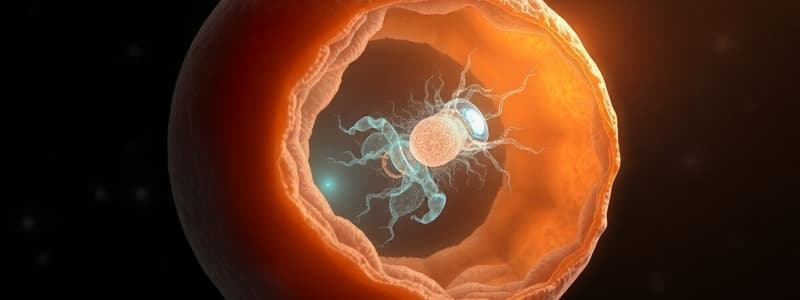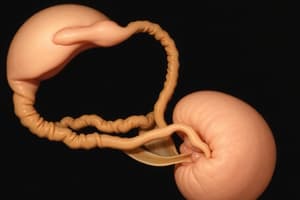Podcast
Questions and Answers
Which cavity encloses the heart and develops from the most interior portion of the intraembryonic coelom?
Which cavity encloses the heart and develops from the most interior portion of the intraembryonic coelom?
- Peritoneal Cavity
- Pericardial Cavity (correct)
- Pleural Cavity
- Thoracic Cavity
What structure separates the pericardial cavity from the pleural cavities?
What structure separates the pericardial cavity from the pleural cavities?
- Septum transversum
- Pleuropericardial folds (correct)
- Lateral body walls
- Pleuroperitoneal folds
The diaphragm originates from which part of the embryonic structure?
The diaphragm originates from which part of the embryonic structure?
- Peritoneal cavity
- Pleuropericardial folds
- Septum transversum (correct)
- Pleural cavities
From which portions of the intraembryonic coelom do the pleural cavities develop?
From which portions of the intraembryonic coelom do the pleural cavities develop?
What is the role of the pleuroperitoneal membranes during development?
What is the role of the pleuroperitoneal membranes during development?
What is the initial space that forms the intraembryonic coelom?
What is the initial space that forms the intraembryonic coelom?
What occurs during the lateral folding of the embryo?
What occurs during the lateral folding of the embryo?
What is the role of the pleuropericardial folds during development?
What is the role of the pleuropericardial folds during development?
What structure helps to separate the thoracic and abdominal cavities?
What structure helps to separate the thoracic and abdominal cavities?
What forms the dorso-ventral structure in the developing embryo?
What forms the dorso-ventral structure in the developing embryo?
Which of the following statements about the pericardioperitoneal canal is true?
Which of the following statements about the pericardioperitoneal canal is true?
What does the ventral mesentery develop from?
What does the ventral mesentery develop from?
What happens to the septum transversum during development?
What happens to the septum transversum during development?
Flashcards
Pericardial Cavity
Pericardial Cavity
The cavity that encloses the heart. It develops from the most interior part of the intraembryonic coelom.
Pleural Cavities
Pleural Cavities
The cavities that enclose each lung. They develop from the lateral portions of the intraembryonic coelom.
Peritoneal Cavity
Peritoneal Cavity
The cavity enclosing most abdominal organs. It develops from the posterior portion of the intraembryonic coelom.
Pleuropericardial Folds
Pleuropericardial Folds
Signup and view all the flashcards
Pleuroperitoneal Folds
Pleuroperitoneal Folds
Signup and view all the flashcards
Intraembryonic Coelom
Intraembryonic Coelom
Signup and view all the flashcards
Pericardioperitoneal Canals
Pericardioperitoneal Canals
Signup and view all the flashcards
Pleuropericardial Folds and Membranes
Pleuropericardial Folds and Membranes
Signup and view all the flashcards
Pleuroperitoneal Folds and Membranes
Pleuroperitoneal Folds and Membranes
Signup and view all the flashcards
Dorsal Mesentery
Dorsal Mesentery
Signup and view all the flashcards
Ventral Mesentery
Ventral Mesentery
Signup and view all the flashcards
Mesentery of Esophagus
Mesentery of Esophagus
Signup and view all the flashcards
Septum Transversum
Septum Transversum
Signup and view all the flashcards
Study Notes
Intraembryonic Coelom Formation
- The intraembryonic coelom arises from the lateral plate mesoderm, which divides into somatic and splanchnic layers.
- The space between these layers constitutes the initial intraembryonic coelom.
- Embryonic folding fuses the lateral body walls, enclosing the coelomic space within the embryo.
Coelomic Partitioning Structures
- Pericardioperitoneal canal: Openings between the thoracic and abdominal cavities, later closed by membranes.
- Pleuropericardial fold/membrane: Mesodermal extensions separating the pericardial and pleural cavities, contributing to the pericardium.
- Pleuroperitoneal fold/membrane: Mesodermal extensions closing the pericardioperitoneal canals, contributing to the diaphragm and separating pleural and peritoneal cavities.
- Dorsal mesentery: Double-layered peritoneum suspending the gut from the dorsal body wall (esophagus to rectum).
- Ventral mesentery: Double-layered peritoneum arising from the septum transversum, connecting liver to ventral body wall (stomach, duodenum).
- Mesentery of esophagus: Double-layered peritoneum for the esophagus, becoming part of the diaphragm's crura.
Septum Transversum Development
- The septum transversum is a mesodermal structure initially cranially located.
- Through body folding and differential growth, it moves caudally to the future diaphragm location.
- It acts as a ventral partition dividing the coelom into thoracic and abdominal cavities.
Adult Body Cavities and Embryonic Origins
- Pericardial Cavity: Derived from the intraembryonic coelom's inner portion. Encloses the heart.
- Pleural Cavities: Derived from the intraembryonic coelom's lateral portions. Encloses the lungs.
- Peritoneal Cavity: Derived from the intraembryonic coelom's posterior portion. Encloses most abdominal organs.
Partitioning of Intraembryonic Coelom
- Pleuropericardial folds fuse, separating the pericardial from pleural cavities.
- Pleuroperitoneal folds/membranes connect to the septum transversum, creating the diaphragm and separating the pleural from peritoneal cavities.
Diaphragm Development
- The diaphragm initially lies high in the neck region.
- As the embryo grows, it descends to its definitive position.
Studying That Suits You
Use AI to generate personalized quizzes and flashcards to suit your learning preferences.
Description
This quiz covers the formation of the intraembryonic coelom from the lateral plate mesoderm and the related partitioning structures. It explores how embryonic folding contributes to coelomic development and the roles of various mesodermal extensions in cavity separation. Test your understanding of these fundamental concepts in embryology.



